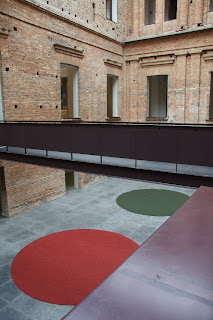
Seeing how small the town was in my taxi ride last night, I decided to do the walking thing in the morning, and headed to my first landmark – 24 Hour Street. Now I am not sure if it’s name was supposed to be true to life, but when I got there, it seemed that no hours were active anymore. The arcade was completely empty, bar a few dusty cardboard boxes.
Deciding then that Curitiba is perhaps not the best place to place a bet, I made my way along Rua Luis Xavier and onto the “Flower Street”, to find the Praça Tiradentes and its guided tourist bus. Fortunately there were actually flowers there, and the first-ever pedestrian mall in the world was busy with artists, street performers and sellers making the most of the cornflower blue sky and Saturday morning trade.
Finally I was starting to see why Curitiba, with all its flowering colour and greeney, is said to have the most greenspace per head of capita, thus following the standard of living. I quickly located the green (very funny) double-decker, open-top bus and promptly burnt my legs on the shining black vinyl. It was a pretty very civilised affair with Mozart playing to me and the other holidaying couples, posing for photos in between kisses.
The bus did of course retrace my previous steps, but with four allowed stops, and a large route set out, I decided to study the map instead, and plan my journey well. The music turned to a cruising beat, stopping intermittently to give an information recording given in Portuguese, Spanish then English. My first exit was at the Botanical Gardens, created in 1991 in a mock-French style aka Versailles.
Accordingly, it was all dark green hedges and brightly arranged daises and annuals. Pom-pom flowers lined the central walkway up to the hothouse of Brazilian plants, with butterflies and bees competing for air space and sweet food. The metal structure ahead looked impressive enough, but once inside is was a pretty thin collection of plants, the only one to catch my interest was the “palmito” that I have been eating with cheese in empadas.
Behind the back of this, and not mentioned in the guide, was the Coleçao Frans Krajcberg Cultural Centre that wraps around the frame in an insulated half-tube. Unfortunately it was closed for renovation, although I could clearly still half-see an interesting collection inside, I quickly get back on the bus. But this time it is a much older model than the last, with no open top, no second level in fact, no music and a very quiet soundtrack that is easily drowned out by the Brazilian tourists who have already started drinking beer at 11am.
From here I head to Oscar Niemeyer’s art museum (it actually has his name this time), affectionately known as “the eye”, after the shape of its design, and I am again blown away at the simple, yet intricate way he creates and uses space. Inside the main building (ie. the ‘sensible’ pavilion at the rear of the entry eye), are three exhibitions spread across the main floor, with a fantastic dedication to the museum’s namesake on the underground level.
It is here that I learn much about Oscar’s motivation and life, and I gain an even deeper respect for the ease at which he seems to consider the world, and the buildings he creates within it. I am sure he would be proud of the congregation of young students having a picnic-pit-stop outside the exit and perhaps be even tempted to join them as they skate all over his masterpiece.






